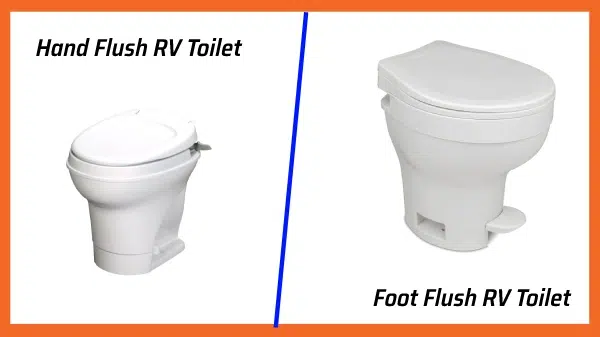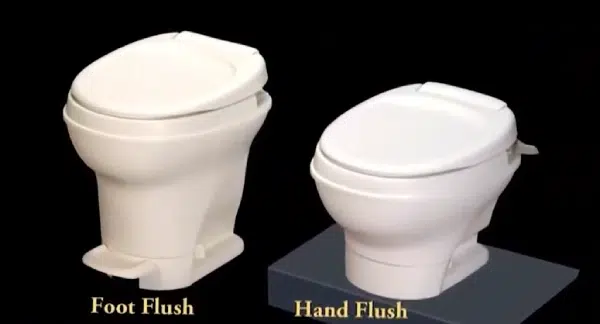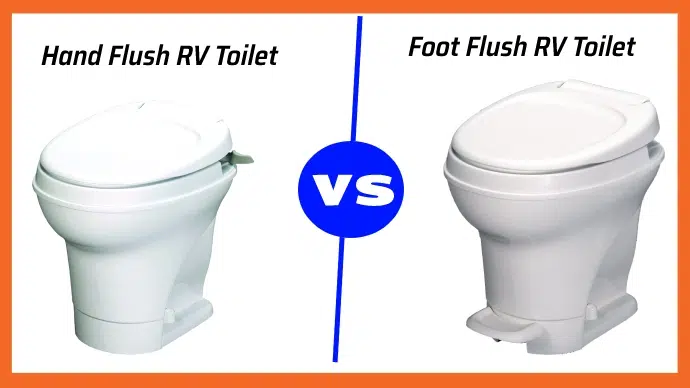Last Updated on April 20, 2023
When searching for the ideal RV toilet, there are many factors to consider, from size and shape to the flushing system and water usage. One crucial decision is whether to opt for a hand or foot-flush toilet.
Both types may appear similar at first glance but have distinct characteristics and benefits. By considering factors such as water usage efficiency, ease of use, maintenance requirements, and cost, you can determine which type of toilet is best suited for your needs.
Many people like hand-flush toilets, but they require more water and are harder to maintain. Alternatively, foot flush toilets save water and are more hygienic, but they’re not easy for everyone.
In this comprehensive guide, we’ll explore the differences between hand-flush and foot-flush toilets and help you make an informed decision that aligns with your needs and preferences. So, take a deep breath and get ready to dive into the world of RV toilets.
Hand Flush VS Foot Flush RV Toilet: Easy Comparison

When choosing between a hand and a foot flush RV toilet, you must consider a few things. Let’s compare the two options:
Ease of Use
Both hand-flush and foot-flush RV toilets have pros and cons when it comes to ease of use.
A lever or button operates hand flush toilets on the toilet bowl’s side. This type of toilet is easy to operate, as users are already familiar with flushing a toilet using a handle or button.
Conversely, foot flush toilets are operated by pressing a pedal located at the base of the toilet with your foot. This type of toilet is ideal for those who may have difficulty reaching a hand flush lever or button. It also allows for hands-free operation, which can be more hygienic in certain situations.
Water Usage Efficiency
Regarding RV toilets, one important factor to consider is water usage efficiency. This refers to the water required to flush the waste down the toilet. In general, foot-flush RV toilets are more water-efficient than hand-flush ones.
Foot flush toilets use a pedal at the toilet’s base, allowing users to control the water flow. This means less water is used with each flush, as users can release the pedal or lever once the bowl has cleared waste.
Alternatively, hand flush toilets require users to manually hold down a lever or button until all waste has been flushed away. This can result in excess water being used if users hold down the lever too long.
In addition to conserving water, foot flush RV toilets are easier on septic systems and can help reduce overall maintenance requirements. By using less water with each flush, foot flush toilets put less strain on septic tanks and prevent them from filling up too quickly.
Maintenance Requirements
Both types of toilets require regular maintenance to ensure they function properly over time. Hand flush toilets typically have more moving parts, such as the handle and valve, which can lead to more frequent maintenance needs. These parts can wear out or become damaged with repeated use, requiring replacement or repair.
Meanwhile, foot flush toilets have fewer moving parts and are generally easier to maintain. The foot pedal mechanism is simple and sturdy, making it less likely to break down or require repairs. Foot flush toilets are also less prone to clogs since they use gravity and water pressure to clear waste from the bowl.
Regular maintenance is essential for proper functioning, regardless of which type of toilet you choose. This includes routine cleaning and sanitizing of the bowl and checking for leaks or damage in the plumbing system.
Cost Comparison
Regarding cost comparison, foot-flush RV toilets are more expensive than hand flush ones. This is because foot flush toilets have more complex mechanisms, such as pedals and valves, which increase manufacturing costs.
However, it is essential to note that the cost difference between the two toilet types is insignificant. In fact, the price range for both hand flush and foot flush RV toilets is relatively similar, with some models costing more or less depending on their features and materials.
Advantages and Disadvantages of Hand Flush RV Toilets

Hand-flush RV toilets are easy to operate and require minimal maintenance. Even though they’re easy to find, there are some pros and cons:
Pros of Hand Flush Toilets
Hand-flush RV toilets are popular among RV owners due to their simplicity and ease of use.
- Don’t Require Extra Components: One of the main advantages of hand flush toilets is that they do not require additional components or electricity to operate, making them a cost-effective option for those on a budget.
- Reliable: Another benefit of hand flush toilets is that they are generally more reliable than foot flush toilets, as fewer moving parts can malfunction.
- Water Usage Control: These toilets give users greater control over water usage. Users can conserve water and reduce their environmental impact by regulating water use during each flush.
- Easier to Clean: These toilets also tend to be easier to clean and maintain than foot flush toilets, as there are no pedals or other components that can become clogged or damaged.
Cons of Hand Flush Toilets
Hand-flush RV toilets have been popular for many years due to their simplicity and affordability. However, they also have some drawbacks that must be considered before purchasing.
- Require Physical Effort: One of the main cons of hand flush toilets is that they require physical effort to operate. This can be inconvenient for those who may have mobility issues or disabilities.
- Less Hygienic: Also, hand flush toilets may not be as hygienic as foot flush toilets because users must touch the handle with their hands, which can spread germs and bacteria.
- Use More Water: Another disadvantage of hand-flush toilets is that they use more water than foot flush toilets. This can lead to higher water bills and strain your RV’s water supply if you’re camping in areas where water is scarce.
- Less Durable: Finally, hand flush toilets are generally less durable than foot-flush toilets because they have more moving parts that can wear out over time. This means that you may need to replace or repair your toilet more frequently.
Advantages and Disadvantages of Foot Flush RV Toilets

Foot flush RV toilets have become increasingly popular among RV enthusiasts due to their unique design and functionality. Here are some pros and cons of Foot Flush RV toilets:
Pros of Foot Flush Toilets
Foot flush RV toilets have several advantages, making them popular among RV enthusiasts. Some of the pros of foot flush toilets include the following:
- Hygiene: Foot flush toilets are considered more hygienic than hand flush toilets because they eliminate the need to touch any part of the toilet with your hands, reducing the risk of spreading germs and bacteria.
- Convenience: With a foot flush toilet, you can easily operate it without using your hands or bending over. This makes it an ideal option for people with mobility issues or who prefer a more convenient toilet use.
- Durability: Foot flush toilets are generally more durable than hand flush toilets because they have fewer moving parts that can break down or malfunction over time.
Cons of Foot Flush Toilets
Despite these advantages, there are also some cons to consider when choosing a foot-flush RV toilet. These include:
- Noise: Foot flush toilets tend to be noisier than hand flush toilets because of the mechanism used to activate the flushing process. This may not be ideal for those who value peace and quiet in their RV bathroom.
- Water usage: Foot flush toilets typically use more water per flush than hand flush toilets. This means they may not be as water-efficient and could lead to higher water bills if you frequently use your RV toilet.
- Require More Maintenance: Foot flush toilets may require more maintenance than hand flush toilets. The pedal mechanism can become worn out over time and may need to be replaced, adding extra costs to your RV maintenance expenses.
Which One is Better: Hand Flush VS Foot Flush RV Toilet?

Both RV Toilet types have advantages and disadvantages, so carefully weighing your options before deciding is essential. Hand flush toilets are operated by pulling a lever or pushing a button. Foot flush toilets, on the other hand, are operated using a pedal at the base of the toilet.
You must consider their pros and cons when deciding between hand and foot-flush RV toilets. Your best choice will depend on your needs and preferences. Take some time to research both types thoroughly before making a decision. That way you can be sure you’ve chosen the right toilet for your RV.
Hand Flush or Foot Flush RV Toilets: What to Consider Before Choosing?
When choosing between a hand flush and a foot flush RV toilet, there are several factors to consider. These factors include:
Personal Preference
Personal preference is essential when choosing between a hand and foot flush for an RV toilet. Some people prefer the traditional hand flush because it gives them more control over the water used, while others prefer the foot flush because it’s more hygienic.
If you have limited space in your RV bathroom, a foot flush toilet may be a better option as it requires less physical space than a hand flush toilet. Conversely, a hand-flush toilet might suit you if you have mobility issues or prefer a more hands-on approach when using the toilet.
Space Availability in the RV Bathroom
The space available in your RV bathroom is important when choosing between a foot flush or hand flush RV toilet. Since RV bathrooms are typically small and compact, choosing a toilet that fits comfortably without taking up too much space is essential.
Hand-flush toilets tend to be more compact than foot-flush toilets since they don’t require additional mechanisms for flushing. They only need a simple lever or button to activate the flushing process. This makes them an excellent choice for RVs with limited bathroom space.
Alternatively, foot flush toilets can take up more space due to their additional pedal mechanism for flushing. However, some models come with a low-profile design that can fit comfortably in most RV bathrooms.
Frequency of Use
When choosing between a hand flush and foot flush RV toilet, one of the factors to consider is the frequency of use. This refers to how often you will use the RV toilet.
If you plan on using your RV frequently or for extended periods, a foot flush toilet may be more convenient. With a foot-flush toilet, you don’t have to touch any handles or buttons with your hands, which can help prevent the spread of germs and bacteria.
Conversely, a hand flush toilet may suffice if you only plan on using your RV occasionally or for short trips. Hand flush toilets are generally less expensive than foot flush toilets and require less maintenance.
RV Toilet Troubles? Weigh the Pros and Cons of Hand-Flush & Foot-Flush Models
The debate between hand and foot flush RV toilets is a matter of personal preference and practicality. Both types of toilets have advantages and disadvantages, and it’s essential to consider various factors before deciding.
Hand-flush toilets are easier for some people but require more water and can be harder to maintain. Meanwhile, foot flush toilets are more water-efficient and hygienic but may not be as easy for everyone.
When choosing between the two types of RV toilets, factors such as personal preference, space availability in the RV bathroom, and frequency of use should be considered. Ultimately, it’s up to the individual RV owner to decide which type of toilet best fits their needs.


